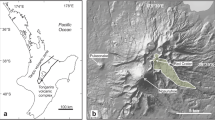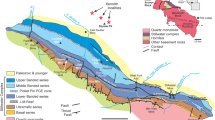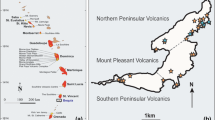Abstract
The petrology of five phenocryst-poor (2–5%) andesites and dacites, all of which were erupted from different short-lived, monogenetic vents, is compared to that of phenocryst-rich (10–25%) andesites erupted from the adjacent stratovolcano, Volcán Tequila, in the Mexican arc. Despite differences in phenocryst abundances, these magmas have comparable phase assemblages (plagioclase + orthopyroxene + titanomagnetite + ilmenite + apatite ± augite ± hornblende), and similarly wide variations in phenocryst compositions, coupled to complex zoning patterns. For the phenocryst-poor lavas, equilibrium pairs of two Fe–Ti oxides lead to a narrow range of calculated temperatures for each sample that range from 934 (±24) to 1,073 (±6)°C and oxygen fugacities that range from +0.1 to +0.7 log units relative to the Ni–NiO buffer. Application of the plagioclase-liquid hygrometer to each sample at these calculated temperatures leads to maximum melt water concentrations of 4.6–3.1 wt% during plagioclase crystallization, indicating that the magmas were fluid saturated at depths ≥6.4–4.5 km. There is a wide, continuous range in the composition of plagioclase (≤44 mol% An) and orthopyroxene (≤16% Mg#) phenocrysts in each sample, which is consistent with a loss of dissolved water (≤2.8 wt%) from the melt phase during degassing as the magmas ascended rapidly to the surface. Evidence is presented that shows the effect of dissolved water is to reduce the activity of MgO relative to FeO in the melt phase, which indicates that degassing will also affect the Mg# of pyroxene phenocrysts, with higher melt water concentrations favoring Fe-rich pyroxene. Both plagioclase and orthopyroxene commonly display diffusion-limited growth textures (e.g., skeletal and hopper crystals, large interior melt hollows, and swallow tails), which are consistent with large undercoolings produced by degassing-induced crystallization. Therefore, degassing is proposed as a possible cause for the phenocryst compositional diversity documented in the phenocryst-poor andesite and dacite lavas erupted from peripheral vents, including the coexistence of normally zoned plagioclase and reversely zoned orthopyroxene. Degassing-induced crystallization may also explain some of the phenocryst complexity in crystal-rich andesites erupted from large stratovolcanoes, including Volcán Tequila.






















Similar content being viewed by others
References
Anderson AT (1984) Probable relations between plagioclase zoning and magma chamber dynamics, Fuego Volcano, Guatemala. Am Mineral 69:660–676
Annen C, Blundy JD, Sparks RJS (2006) The genesis of intermediate and silicic magmas in deep crustal hot zones. J Petrol 47:505–539
Bacon CR, Hirschmann MM (1988) Mg/Mn partitioning as a test for equilibrium between coexisting Fe–Ti oxides. Am Mineral 73:57–61
Bandy W, Mortera-Gutierrez C, Urrutia-Fucugauchi J, Hilde TWC (1995) The subducted Rivera-Cocos plate boundary: where is it, what is it, and what is its relationship to the Colima rift? J Geophys Res Lett 22:3075–3078
Bindeman IN, Davis AM (2000) Trace element partitioning between plagioclase and melt: investigation of dopant influence on partition behavior. Geochim Cosmochim Acta 64:2863–2878
Bindeman IN, Davis AM, Drake MJ (1998) An ion microprobe study of plagioclase-basalt partition experiments at natural concentration levels of trace elements. Geochim Cosmochim Acta 62:1175–1192
Blatter DL, Carmichael ISE (1998) Plagioclase-free andesites from Zitácuaro (Michoacán), Mexico: petrology and experimental constraints. Contrib Mineral Petrol 132:121–138
Blatter DL, Carmichael ISE (2001) Hydrous phase equilibria of a Mexican high-silica andesite: a candidate for a mantle origin? Geochim Cosmochim Acta 65:4043–4065
Blundy JD, Shimizu N (1991) Trace element evidence for plagioclase recycling in calc-alkaline magmas. Earth Planet Sci Lett 102:178–197
Blundy JD, Wood BJ (1991) Crystal-chemical controls on the partitioning of Ba and Sr between plagioclase feldspar, silicate melts and hydrothermal solutions. Geochim Cosmochim Acta 55:193–209
Burgisser A, Scaillet B (2007) Redox evolution of a degassing magma rising to the surface. Nature 445:194–197
Carmichael ISE (2002) The andesite aqueduct: perspectives on the evolution of magmatism in west-central (105–99°W) Mexico. Contrib Mineral Petrol 143:641–663
Carmichael ISE, Turner FJ, Verhoogen J (1974) Igneous petrology. McGraw-Hill Book Co, New York, p 739
Cashman K, Blundy J (2000) Degassing and crystallization of ascending andesite and dacite. Philos Trans R Soc Lond A358:1487–1513
Chase MW (1998) NIST-JANAF thermochemical tables, 4th edn. Journal of Physical Chemistry Reference Data, Monograph 9. Springer, Heidelberg
Chertkoff DG, Gardner JE (2004) Nature and timing of magma interactions before, during and after caldera-forming eruption of Volcán Ceboruco, Mexico. Contrib Mineral Petrol 146:715–735
Costa F, Scaillet B, Pichavant M (2004) Petrological and experimental constraints on the pre-eruption conditions of Holocene dacite from Volcan San Pedro (36°S, Chilean Andes) and the importance of sulphur in silicic subduction-related magmas. J Petrol 45:855–881
Couch S, Sparks RSJ, Carroll MR (2003) The kinetics of degassing-induced crystallization at Soufriere Hills Volcano, Montserrat. J Petrol 44:1477–1502
Crabtree SM, Lange RA (2010a) Complex phenocryst textures and zoning patterns in andesites and dacites: evidence of degassing-induced crystallization? J Petrol [Epub ahead of print]
Crabtree SM, Lange RA (2010b) An evaluation of the effect of degassing on the oxidation state of hydrous andesite and dacite magmas: a comparison of pre- and post-eruptive Fe2+ concentrations. Contrib Mineral Petrol (in review)
Delgado-Granados H (1993) Late Cenozoic tectonics offshore western Mexico and its relation to the structure and volcanic activity in the western Trans-Mexican Volcanic Belt. Geofísica Internacional 32:543–559
Demant A (1979) Vulcanologia y petrografia del sector occidental del eje neovolcanico. UNAM Inst Geol Rev 3:39–57
Gaetani GA, Grove TL (1998) The influence of water on melting of mantle peridotite. Contrib Mineral Petrol 131:323–346
Ganguly J, Tazzoli V (1994) Fe2+-Mg interdiffusion in orthopyroxene: retrieval from the data on intracrystalline exchange reaction. Am Mineral 79:930–937
Gardner JE, Rutherford M, Carey S, Sigurdsson H (1995) Experimental constraints on pre-eruptive water contents and changing magma storage prior to explosive eruptions of Mount St. Helens volcano. Bull Volcanol 57:1–17
Ghiorso MS, Evans BW (2008) Thermodynamics of rhombohedral oxide solid solutions and a revision of the Fe–Ti two-oxide geothermometer and oxygen barometer. Am J Sci 308:957–1039
Ginibre C, Wörner G (2007) Variable parent magmas and recharge regimes of the Parinacota magma system (N. Chile) revealed by Fe and Sr zoning in plagioclase. Lithos 98:118–140
Grove TL, Juster TC (1989) Experimental investigations of low-Ca pyroxene stability and olivine-pyroxene-liquid equilibria at 1 atm in natural basaltic and andesitic liquids. Contrib Mineral Petrol 103:287–305
Grove TL, Elkins-Tanton LT, Parman SW, Chatterjee N, Müntener O, Gaetani GA (2003) Fractional crystallization and mantle-melting controls on calc-alkaline differentiation trends. Contrib Mineral Petrol 145:515–533
Hammer JE (2006) Influence of fO2 and cooling rate on the kinetics and energetics of Fe-rich basalt crystallization. Earth Planet Sci Lett 248:618–637
Hammer JE, Rutherford MJ (2002) An experimental study of the kinetics of decompression-induced crystallization in silicic melt. J Geophys Res 107. doi:10.1029/2001JB00281
Harris JM (1986) Silicic volcanics of Volcán Tequila, Jalisco, Mexico. MS thesis, University of California
Holtz F, Johannes W (1994) Maximum and minimum water contents of granitic melts; implications for chemical and physical properties of ascending magmas. Lithos 32:149–159
Holtz F, Sato H, Lewis J, Behrens H, Nakada S (2005) Experimental petrology of the 1991–1995 Unzen dacite, Japan. Part 1: phase relations, phase composition and pre-eruptive conditions. J Petrol 46:319–337
Housh TB, Luhr JF (1991) Plagioclase-melt equilibria in hydrous systems. Am Mineral 76:477–492
Hui H, Zhang Y (2007) Toward a general viscosity equation for natural anhydrous and hydrous silicate melts. Geochim Cosmochim Acta 71:403–416
Humphreys MCS, Blundy JD, Sparks RSJ (2006) Magma evolution and open-system processes at Shiveluch Volcano: insights from phenocryst zoning. J Petrol 47:2303–2334
Johannes W, Koepke J, Behrens H (1994) Partial melting reactions of plagioclase and plagioclase-bearing assemblages. In: Parson I (ed) Feldspars and their reactions. Kluwer, Dordrecht, pp 161–194
Kawamoto T (1992) Dusty and honeycomb plagioclase: indicators of processes in the Uchino stratified magma chamber, Izu Peninsula, Japan. J Volcanol Geotherm Res 49:191–208
Kinzler RJ (1997) Melting of mantle peridotite at pressures approaching the spinel to garnet transition: application to mid-ocean ridge basalt petrogenesis. J Geophys Res 102:853–874
Kinzler RJ, Grove TL (1992) Primary magmas of mid-ocean ridge basalts. 1. Experiments and methods. J Geophys Res 97:6885–6906
Kress VC, Carmichael ISE (1991) The compressibility of silicate liquids containing Fe2O3 and the effect of composition, temperature, oxygen fugacity and pressure on their redox states. Contrib Mineral Petrol 108:82–92
Kudo AM, Weil DF (1970) An igneous plagioclase thermometer. Contrib Mineral Petrol 25:52–65
Kuo LC, Kirkpatrick RJ (1982) Pre-eruption history of phyric basalts from DSDP Legs 45 and 46: evidence from morphology and zoning patterns in plagioclase. Contrib Mineral Petrol 79:13–27
Lange RA, Frey HM, Hector J (2009) A thermodynamic model for the plagioclase-liquid hygrometer/thermometer. Am Mineral 94:494–506
Larsen JF (2005) Experimental study of plagioclase rim growth around anorthite seed crystals in rhyodacite melt. Am Mineral 90:417–427
Larsen JF (2006) Rhyodacite magma storage conditions prior to the 3430 yBP caldera-forming eruption of Aniakchak volcano, Alaska. Contrib Mineral Petrol 152:523–540
Lewis-Kenedi CB, Lange RA, Hall CM, Delgado Granados H (2005) The eruptive history of the Tequila volcanic field, western Mexico. Bull Volcanol 67:391–414
Lofgren G (1974) An experimental study of plagioclase crystal morphology: isothermal crystallization. Am J Sci 274:243–273
Luhr JF (1992) Slab-derived fluids and partial melting in subduction zones: insights from two contrasting Mexican volcanoes (Colima and Ceboruco). J Volcanol Geotherm Res 54:1–18
Luhr JF (2000) The geology and petrology of Volcán San Juan (Nayarit, México) and the compositionally zoned Tepic Pumice. J Volcanol Geotherm Res 95:109–156
Luhr JF, Carmichael ISE (1980) Colima volcanic complex, Mexico. 1. Post-caldera andesites from Volcan Colima. Contrib Mineral Petrol 71:343–373
Martel C, Schmidt BC (2003) Decompression experiments as an insight into ascent rates of silicic magmas. Contrib Mineral Petrol 144:397–415
Martel C, Pichavant M, Holtz F, Scaillet B (1999) Effects of fO2 and H2O on andesite phase relations between 2 and 4 kbar. J Geophys Res 104:29453–29470
McCanta MC, Rutherford MJ, Hammer JE (2007) Pre-eruptive and syn-eruptive conditions in the Black Butte, California dacite: insight into crystallization kinetics in a silicic magma system. J Volcanol Geotherm Res 160:263–284
Moore G, Carmichael ISE (1998) The hydrous phase equilibria (to 3 kbar) of an andesite and basaltic andesite from western Mexico: constraints on water content and conditions of phenocryst growth. Contrib Mineral Petrol 130:304–319
Moore G, Vennemann T, Carmichael ISE (1998) An empirical model for the solubility of H2O in magmas to 3 kilobars. Am Mineral 83:36–42
Morse SA (1984) Cation diffusion in plagioclase feldspar. Science 225:504–505
Muncill GE, Lasaga AC (1987) Crystal-growth kinetics of plagioclase in igneous systems: one-atmosphere experiments and application of a simplified growth model. Am Mineral 72:299–311
Nakamura M, Shimakita S (1998) Dissolution origin and syn-entrapment compositional change of melt inclusion in plagioclase. Earth Planet Sci Lett 161:119–133
Nelson SA (1980) Geology and petrology of Volcan Ceboruco, Nayarit, Mexico. Geol Soc Am Bull 91:639–643
Nelson SA, Livieres RA (1986) Contemporaneous calc-alkaline and alkaline volcanism at Sanganguey Volcano, Nayarit, Mexico. Geol Soc Am Bull 97:798–808
Nelson ST, Montana A (1992) Sieve-textured plagioclase in volcanic rocks produced by rapid decompression. Am Mineral 77:1242–1249
Newman S, Lowenstern JB (2002) VolatileCalc: a silicate melt-H2O-CO2 solution model written in Visual Basic for excel. Comput Geosci 28:597–604
Panjasawatwong Y, Danyushevsky LV, Crawford AJ, Harris KL (1995) An experimental study of the effects of melt composition on plagioclase; melt equilibria at 5 and 10 kbar; implications for the origin of magmatic high-An plagioclase. Contrib Mineral Petrol 118:420–432
Pichavant M, Martel C, Bourdier JL, Scaillet B (2002) Physical conditions, structure, and dynamics of a zoned magma chamber: Mount Pelée (Martinique, Lesser Antilles Arc). J Geophys Res 197. doi:10.1029/2001JB000315
Putirka K (2005) Igneous thermometers and barometers based on plagioclase + liquid equilibria: test of some existing models and new calibrations. Am Mineral 90:336–346
Reubi O, Blundy J (2008) Assimilation of plutonic roots, formation of high-K ‘exotic’ melt inclusions and genesis of andesitic magmas at Volcán de Colima, Mexico. J Petrol 49:2221–2243
Scaillet B, Evans BW (1999) The 15 June 1991 eruption of Mount Pinatubo. I. Phase equilibria and pre-eruption P–T–fO2–fH2O conditions of the dacite magma. J Petrol 40:381–411
Sisson TW, Grove TL (1993) Experimental investigations of the role of H2O in calc-alkaline differentiation and subduction zone magmatism. Contrib Mineral Petrol 113:143–166
Streck M (2008) Mineral textures and zoning as indicators for open system processes. Rev Mineral Geochem 69:595–622
Suzuki Y, Gardner JE, Larsen JF (2007) Degassing and microlite crystallization of basaltic andesite magma erupting at Arenal volcano, Costa Rica. J Volcanol Geotherm Res 157:182–201
Tsuchiyama A (1985) Dissolution kinetics of plagioclase in the melt of the system diopside-albite-anorthite and origin of dusty plagioclase in andesites. Contrib Mineral Petrol 89:1–16
Wallace PJ (2005) Volatiles in subduction zone magmas: concentrations and fluxes based on melt inclusion and volcanic gas data. J Volcanol Geotherm Res 140:217–240
Wallace PJ, Carmichael ISE (1994) Petrology of Volcán Tequila, Jalisco, Mexico: disequilibrium phenocryst assemblages and evolution of the subvolcanic magma system. Contrib Mineral Petrol 117:345–361
Wopat MA (1990) Quaternary alkaline volcanism and tectonics in the Mexican Volcanic Belt near Tequila, Jalisco, southwestern Mexico. PhD dissertation, University of California
Acknowledgments
This work was supported by the National Science Foundation: EAR-0409052 (research grant) and EAR-9911352 (equipment grant for the electron microprobe at the University of Michigan). We thank Matthew Manon for his analytical expertise with the microprobe analyses, and Sarah North, undergraduate at the University of Michigan, for her assistance with collecting microprobe data. We are especially grateful for the constructive and insightful comments from Julia Hammer, Gordon Moore, Paul Wallace and an anonymous reviewer, which substantially improved the manuscript.
Author information
Authors and Affiliations
Corresponding author
Additional information
Communicated by G. Moore.
Electronic supplementary material
Below is the link to the electronic supplementary material.
Rights and permissions
About this article
Cite this article
Frey, H.M., Lange, R.A. Phenocryst complexity in andesites and dacites from the Tequila volcanic field, Mexico: resolving the effects of degassing vs. magma mixing. Contrib Mineral Petrol 162, 415–445 (2011). https://doi.org/10.1007/s00410-010-0604-1
Received:
Accepted:
Published:
Issue Date:
DOI: https://doi.org/10.1007/s00410-010-0604-1




